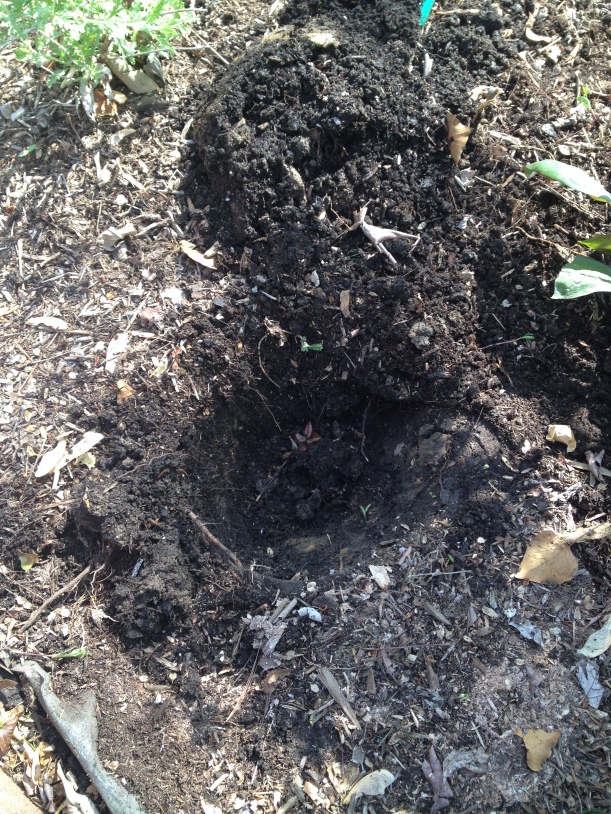 I love it when a plant is described as a “solution.” But that’s not what led me to select and plant Acer griseum, commonly called a paperbark maple due to its distinguising feature of peeling bark. T
I love it when a plant is described as a “solution.” But that’s not what led me to select and plant Acer griseum, commonly called a paperbark maple due to its distinguising feature of peeling bark. T
No, I chose this tree because my yard is small and I wanted a smallish tree that would give more of an enveloping feeling to the space at the patio’s edge. We all know site selection is important when buying plants, and I’d say it’s very important when buying trees. They’re expensive and not easy to rip out like, say, daylilies or other type of perennial.
 So I considered not just my need for a more cozy spot, but also the fact that the site gets mostly full sun, is made of clay soil and I wanted to reduce the step down from the patio to the yard. Beyond these technical considerations, I wanted a tree that provides fall or winter interest. Winter is St. Louis is dreary. I like looking out something beyond a gray landscape. So far, additions of a drawf blue spruce (looks awesome in snow!) and winterberry have helped establish more four-season interest.
So I considered not just my need for a more cozy spot, but also the fact that the site gets mostly full sun, is made of clay soil and I wanted to reduce the step down from the patio to the yard. Beyond these technical considerations, I wanted a tree that provides fall or winter interest. Winter is St. Louis is dreary. I like looking out something beyond a gray landscape. So far, additions of a drawf blue spruce (looks awesome in snow!) and winterberry have helped establish more four-season interest.

Here’s a “before” photo. We had lots of rain this spring so there was a considerable lag time from when I bought the tree and when the landscaper could plant it. I prepped the site by killing the grass with glyphosate.
 I’ve thought long and hard about what I wanted in this spot. Maybe an attractive shrub row with great fall interest, such as burning bush (euonymus alatus), or a tree that would provide dappled light, like river birch (betula nigra). I love the peeling bark of river birch, but I don’t care for its leaves all that much. A row of shrubs would obscure my view of my shade garden and would be too much of a repetition in size; I already have several shrubs of similar height. Oh, and I like clumping or multi-stemmed trunks.
I’ve thought long and hard about what I wanted in this spot. Maybe an attractive shrub row with great fall interest, such as burning bush (euonymus alatus), or a tree that would provide dappled light, like river birch (betula nigra). I love the peeling bark of river birch, but I don’t care for its leaves all that much. A row of shrubs would obscure my view of my shade garden and would be too much of a repetition in size; I already have several shrubs of similar height. Oh, and I like clumping or multi-stemmed trunks.
 Of course, I did lots and lots of online research and visited my favorite nurseries and the Missouri Botanical Gardens once or twice to look at trees I that interested me. By the way, MoBot has a wonderful plant finder tool on its web site. This is what a came across when I did a search for paperbark maple:
Of course, I did lots and lots of online research and visited my favorite nurseries and the Missouri Botanical Gardens once or twice to look at trees I that interested me. By the way, MoBot has a wonderful plant finder tool on its web site. This is what a came across when I did a search for paperbark maple:
Attaining a height of 20 to 30′, paperbark maple is an excellent choice for small properties. This slowgrowing tree features beautiful peeling cinnamon to reddish brown bark and trifoliate leaves that turn red in fall. Its two-winged seeds tend to be infertile and will not produce as many unwanted seedlings in lawns as other maples.
Other pages on the MoBot web site describe the tree as a great choice for clay soil. Problem solved. The tree is larger than I can manage so a local landscaper planted it for me this spring. If I have one regret, it’s that the paperbark is a slow grower. It’s going to take a few years for it to fill in and lend that enveloping feeling I’m seeking. But all things considered, I would definately describe this tree as a “solution.”




